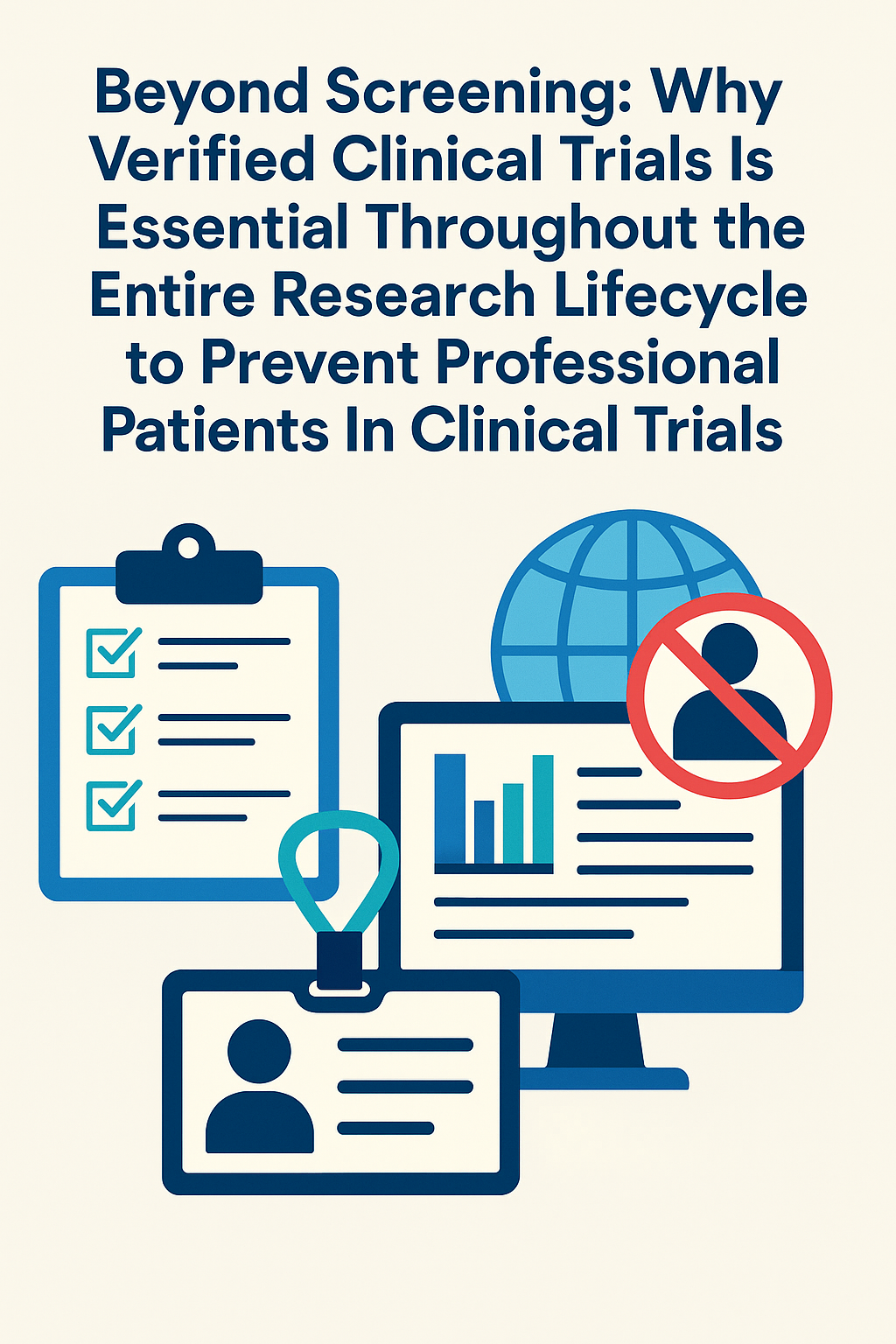Preventing professional patients in clinical trials, duplicate research subjects, and dual enrollment in clinical trials isn’t just a Day 1 problem — it’s a long‑term necessity.
In clinical research, subject risk is often assumed to be limited to eligibility at screening. But what happens after randomization? What about long-term follow-up, crossover phases, or open-label extensions?
Verified Clinical Trials (VCT) protects your trial from these underappreciated risks — far beyond Day 1.
The Persistent Threat of Professional Patients and Duplicate Research Subjects
Professional patients in clinical trials and duplicate research subjects are increasingly common across therapeutic areas. These individuals enroll serially or concurrently—often seeking financial incentives or repeated access to investigational treatments. While screening day typically flags obvious duplications, many issues arise post-randomization:
- Subjects enrolling in multiple cohorts or arms of the same study.
- Dual enrollment in clinical trials across sponsors or indications.
- Protocol washout violations or early re-entry in follow-up phases.
These behaviors compromise safety, skew results, and inflate costs — indicating the need for ongoing vigilance.
Why VCT Protects Your Study Throughout the Entire Lifecycle
Verified Clinical Trials is more than a screening tool; it’s a global, cross-sponsor network that provides continuous protection:
🔒 Pre‑randomization & Beyond
VCT flags dual enrollment in clinical trials not just at screening, but also during re-randomization, extensions, or follow-up, helping prevent duplicate research subjects throughout the study.
🌐 Global Cross-Sponsor Visibility
Operating in nearly 40 countries, VCT supports trials across therapeutic areas—including CNS, obesity, vaccines, dermatology, respiratory, ophthalmology, GLP‑1, and rare disease studies Verified Clinical Trials+5PharmiWeb.com+5Verified Clinical Trials+5Verified Clinical TrialsLinkedIn+5Verified Clinical Trials+5Verified Clinical Trials+5.
🧾 Optional Biometric Verification
Facial recognition and fingerprint tools help ensure accurate identity tracking—deterring aliases and impersonation.
🕒 Lifecycle Application
From Phase I to Phase IV, VCT monitors participants through the entire study period, safeguarding data integrity and participant safety.
💰 ROI That Extends Past Day 1
By preventing enrollment of professional research participants and duplicate subjects, VCT enhances statistical validity, reduces screen failures, and speeds up study timelines—saving sponsors significant time and budget Verified Clinical TrialsLinkedIn+3PharmiWeb.com+3Verified Clinical Trials+3.
Supporting Evidence & Further Reading
- ClinicalTrials.gov lists thousands of active interventional studies across high-traffic areas like dermatology, respiratory, and ophthalmology—areas particularly susceptible to duplication risk arXiv+12Verified Clinical Trials+12Clinical Trial Vanguard+12.
- Executive Interview: How to Avoid the Dangers of Duplicate Participants in Clinical Trials (Clinical Trial Vanguard) provides real-world insight into VCT’s technology and impact Verified Clinical Trials+7Clinical Trial Vanguard+7Verified Clinical Trials+7.
- Industry Article: Preventing Duplicate and Professional Research Subjects in Clinical Trials: How Verified Clinical Trials Safeguards Data Integrity and Subject Safety (PharmiWeb, June 2025) details how VCT’s registry identifies risky enrollments and enforces protocol compliance research.cuanschutz.edu+10PharmiWeb.com+10Verified Clinical Trials+10.
Real-World Impact by the Numbers
- Estimated duplicate rates exceed 5–10% across many therapeutic areas, including obesity, CNS, and vaccine trials Verified Clinical Trials.
- Even a single duplicate subject can distort endpoint outcomes, elevate placebo rates, mask adverse events, or lead to trial failure.
- VCT’s pre-screening detection prevents millions in downstream costs by stopping ineligible enrollments early Verified Clinical Trials+2Verified Clinical Trials+2Pubs – Clinical Research News Online+2Verified Clinical Trials+2Verified Clinical Trials+2Verified Clinical Trials+2.
✅ Final Takeaway
The risk of professional patients in clinical trials, duplicate research subjects, and dual enrollment in clinical trials extends well beyond screening. It’s a continual threat—across phases, sponsors, sites, and countries. Only Verified Clinical Trials offers the real-time, cross-sponsor, lifecycle-long protection needed to safeguard your study’s integrity, participants, and timeline.
Explore active and recruiting trials on ClinicalTrials.gov to see for yourself how widespread the exposure is—and how essential prevention tools like VCT have become.

